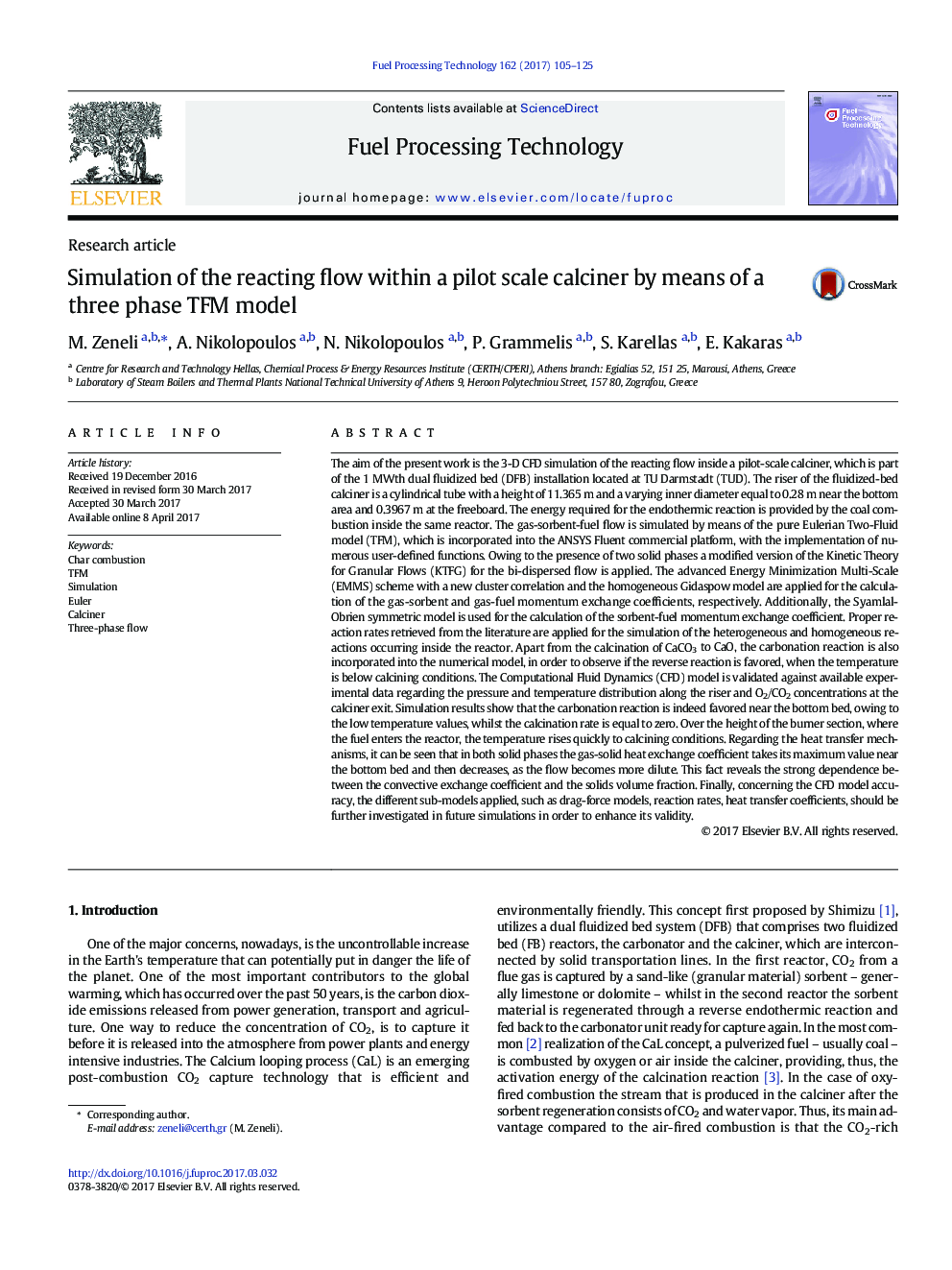| کد مقاله | کد نشریه | سال انتشار | مقاله انگلیسی | نسخه تمام متن |
|---|---|---|---|---|
| 4768913 | 1425384 | 2017 | 21 صفحه PDF | دانلود رایگان |
عنوان انگلیسی مقاله ISI
Simulation of the reacting flow within a pilot scale calciner by means of a three phase TFM model
دانلود مقاله + سفارش ترجمه
دانلود مقاله ISI انگلیسی
رایگان برای ایرانیان
کلمات کلیدی
موضوعات مرتبط
مهندسی و علوم پایه
مهندسی شیمی
مهندسی شیمی (عمومی)
پیش نمایش صفحه اول مقاله

چکیده انگلیسی
The aim of the present work is the 3-D CFD simulation of the reacting flow inside a pilot-scale calciner, which is part of the 1Â MWth dual fluidized bed (DFB) installation located at TU Darmstadt (TUD). The riser of the fluidized-bed calciner is a cylindrical tube with a height of 11.365Â m and a varying inner diameter equal to 0.28Â m near the bottom area and 0.3967Â m at the freeboard. The energy required for the endothermic reaction is provided by the coal combustion inside the same reactor. The gas-sorbent-fuel flow is simulated by means of the pure Eulerian Two-Fluid model (TFM), which is incorporated into the ANSYS Fluent commercial platform, with the implementation of numerous user-defined functions. Owing to the presence of two solid phases a modified version of the Kinetic Theory for Granular Flows (KTFG) for the bi-dispersed flow is applied. The advanced Energy Minimization Multi-Scale (EMMS) scheme with a new cluster correlation and the homogeneous Gidaspow model are applied for the calculation of the gas-sorbent and gas-fuel momentum exchange coefficients, respectively. Additionally, the Syamlal-Obrien symmetric model is used for the calculation of the sorbent-fuel momentum exchange coefficient. Proper reaction rates retrieved from the literature are applied for the simulation of the heterogeneous and homogeneous reactions occurring inside the reactor. Apart from the calcination of CaCO3 to CaO, the carbonation reaction is also incorporated into the numerical model, in order to observe if the reverse reaction is favored, when the temperature is below calcining conditions. The Computational Fluid Dynamics (CFD) model is validated against available experimental data regarding the pressure and temperature distribution along the riser and O2/CO2 concentrations at the calciner exit. Simulation results show that the carbonation reaction is indeed favored near the bottom bed, owing to the low temperature values, whilst the calcination rate is equal to zero. Over the height of the burner section, where the fuel enters the reactor, the temperature rises quickly to calcining conditions. Regarding the heat transfer mechanisms, it can be seen that in both solid phases the gas-solid heat exchange coefficient takes its maximum value near the bottom bed and then decreases, as the flow becomes more dilute. This fact reveals the strong dependence between the convective exchange coefficient and the solids volume fraction. Finally, concerning the CFD model accuracy, the different sub-models applied, such as drag-force models, reaction rates, heat transfer coefficients, should be further investigated in future simulations in order to enhance its validity.
ناشر
Database: Elsevier - ScienceDirect (ساینس دایرکت)
Journal: Fuel Processing Technology - Volume 162, July 2017, Pages 105-125
Journal: Fuel Processing Technology - Volume 162, July 2017, Pages 105-125
نویسندگان
M. Zeneli, A. Nikolopoulos, N. Nikolopoulos, P. Grammelis, S. Karellas, E. Kakaras,